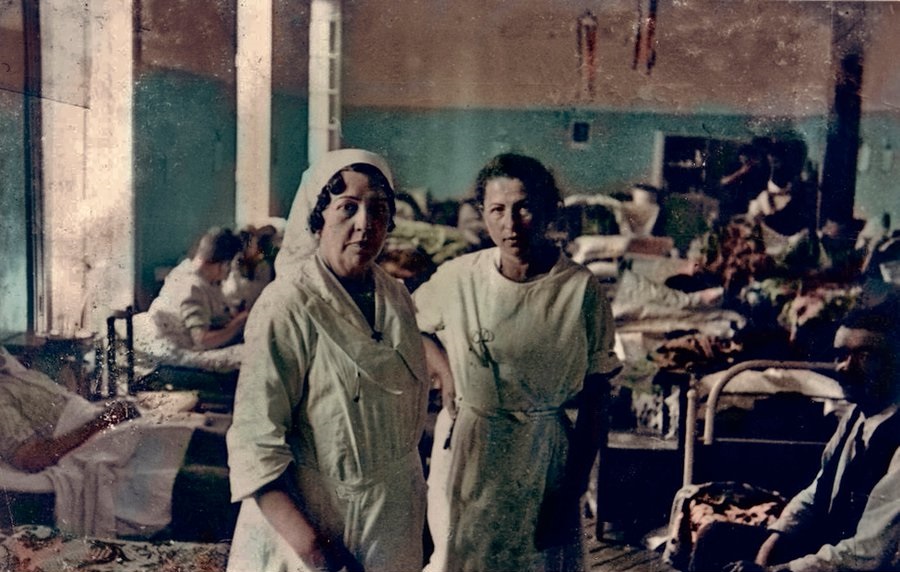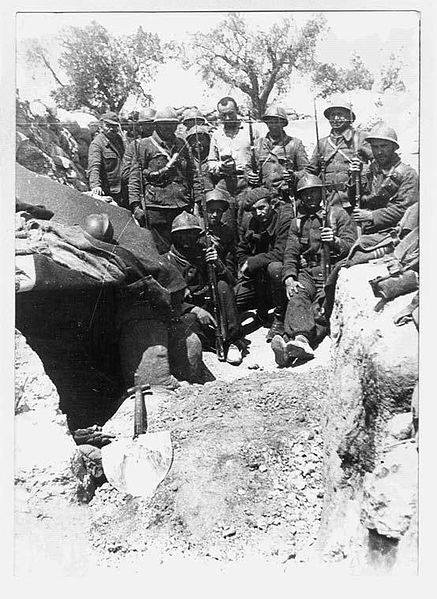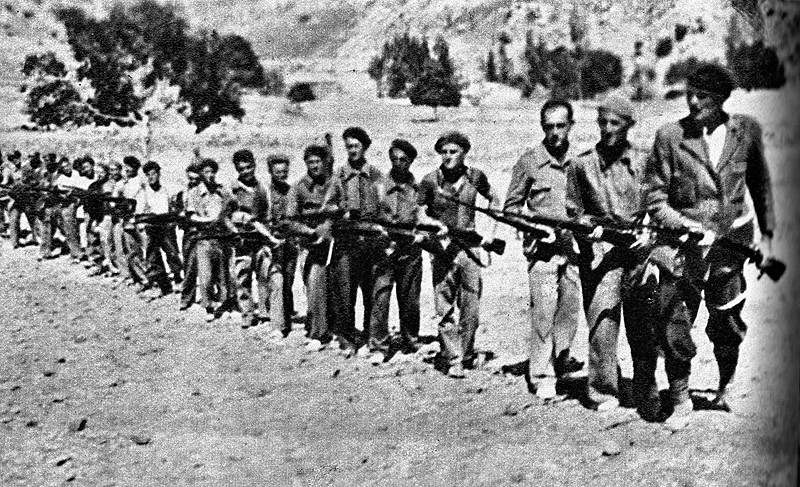The total number of Yugoslavs in Spain differs according to researchers. The French historian, Hervé Lemesle, states that the total exceeds 1900, with the main contingent being Croatian, followed by Slovenes and Serbs. A majority were workers from many sectors and peasants. There were also doctors, engineers, teachers, journalists, and students. Most traveled from Yugoslavia, although there were groups of exileds or migrants from many European countries, as well as the US, Canada or Argentina.
The number of deaths (including MIA) in Spain is close to 800, a very high percentage (40%), although other studies estimate 32%. At any rate, it’s higher than the average losses for the International Brigades (27%). The most notorious victim was Blagoje Parović [Šmit, nom de guerre], part of the Communist Party of Yugoslavia’s Central Committee and political commissar of the XIII International Brigade, who died the first day in the Battle of Brunete. His remains were buried in the Fuencarral cemetery.
There were 16 Yugoslav women in the Health Services. The oldest was 43, while the youngest were only 22 years old. Most of the female volunteers arrived in Spain in 1937, from the Kingdom of Yugoslavia or countries such as Algeria, Belgium, Czechoslovakia, France, and Uruguay. Some of those women had been active agents of the worker movement or even members of the CPY before leaving for Spain. Those who lacked medical training attended a preparation course beforehand. They worked in the hospitals of Murcia, Albacete, Benicasim, Denia, Madrigeras, Vic, and other cities. Avgust Lesnik writes: “There were 16 women: doctors Adela Bohunicki, Nada Dimitrijević-Nešković, and Dobrila Mezić-Šiljak, [as well as the nurses] Ana-Marija Basch (Baš), Olga Dragić-Belović (Milić Milica), Elizabeta-Liza Gavrić, Marija-Peči Glavaš, Marija Habulin, Lea Kraus, Tereza Kučera, Lujza Pihler (Demić Borka), Ottilia Reschitz-Zanoni, Ana Seles-Brozović, Kornelija Sende-Popović, Eugenia Simonetti, and Marija Šneeman”.
 Borka Demic (right) in the Pasionaria Hospital of Murcia (colored by Tina Paterson)
Borka Demic (right) in the Pasionaria Hospital of Murcia (colored by Tina Paterson)
If I were to be born again, I’d continue fighting for the ideals of my youth. Then, nothing was difficult and I don’t regret anything
- B. Demic
After the formation of the International Brigades, the Yugoslav volunteers were distributed throughout different units. For instance, the Edgar André battalion had 36, the Thälmann had 93, Garibaldi had 40, and Chapaiev had 78. The main body of Yugoslavs, however, were first integrated into the Balkan company of the Dombrowski battalion (120), and immediately after, into the Dimitrov battalion. By early 1938 a good portion of the Yugoslavs were integrated into two of the 129th Brigade’s battalions: Dimitrov (191) and Djaković (150). They were also a part of the 45th International Division (108)
There was Yugoslav presence in various arms and services: 4 in aviation; 12 in transport units, 1 in the navy, 33 in the International Brigades’ health service, and 26 in the guerrilla groups (one of the most experienced of which was Ljubomir Ilič). More important than this was their presence (131 members) in the artillery arm, of which there were 21 in the heavy artillery Slav Group, 22 in the 2nd heavy artillery Škoda Group’s Liebknecht Battery, 18 in the 3rd heavy artillery Group, 38 in the 4th anti-tank Group’s Stjepan Radić battery, 6 in the 35 Division’s Ana Pauker artillery Group, 5 in the 45 Division’s Rosa Luxembourg artillery Group, and 21 in the Gottwald battery. Furthermore, 65 Yugoslavs fought in the Spanish units of the Republican Army. (Avgust Lesnik)
They fought in almost every front in Spain, from the defense of Madrid to the very last battles of the retreat into France (Januray-February 1939) being an example of fearlessness and courage, because of which a good part of them received war medals from the Spanish Republican Government.
As has been explained in another article, the Dimitrov battalion was formed in January 1937 in the instructional base in Mahora. They entered battle the 12th of February in the Jarama battle, which finished the 27th of that same month. Then, until mid June, it stayed covering that front with the other battalions of the XV International Brigade.

After a two week rest in Ambite (Tajuña valley), the XV Brigade travelled to Madrid’s north to take part of the first great republican offensive in Brunete. Combat started during the night of the 5th to the 6th of July. The XV International Brigade was a part of, along with the XIII and 16 BM, the XV Division under general Gal’s command [János Gálicz, a Soviet-Hungarian officer who also led the Lincoln Battalion]. The mission was to take the heights of Romanillos (XIII IB) and Mosquito (XV IB). It wasn’t possible because operations were slow and the brigades could not take the important francoist positions. The Dimitrov went as far as taking the Miraval Olive Grove, but in the 18th of July, when the first francoist counter-offensive commences, they lost it. Since that point, the republican positions began to retreat until the 22nd, when they were forced to cross back through the Guadarrama river. The XV IB was relieved the 26th of July and went back to where they began the offensive.
In late July, the Dimitrov returned to Ambite (Tajuña valley) and was able to reorganize: the battalion, that had arrived with 143 combatants, reached 563. In this way, in the 24th of August, it threw itself with renewed force against the Aragonian village of Quinto, which fell in the 26th. During the taking of the village and the Purburell hill, which defended them to the east, the Dimitrov battalion’s courage stood out. The same was true in the fierce week-long combat to subdue Belchite.
After this battle, the Dimitrov was detached from the XV Brigade and, during the few following months, was a part of, along with the Djuro Djakovic battalion, the 45th International Division’s Reserve Group. It was a period that they dedicated to military education and to the surveillance of the Huesca Front from the second line. In January 1938 they received the order to transfer to the Southern Front. Close to Almadén, in Chillón, the last International Brigade was formed, the 129th; composed of these two battalions plus the newly created Masaryk battalion.
Composed primarily of Yugoslav volunteers, plus a few Czechoslovaks and Bulgarians, adopted their name in memory of that Croat revolutionary and member of the CPY, tortured and executed in 1929 by order of the king and dictator Alexander the First.
It was formed in April 1937 from the Balkan Company of the Dombrowski battalion. This Company had participated, with the Dombrowski, in the Defense of Madrid and in the battles of Boadilla, Jarama, and Guadalajara. Its excellent conduct pushed general Lukács [Béla Frankl, or Máté Zalka, nom de guerre Pál Lukács, a Hungarian veteran of the Russian Civil War, where he fought alongside the Bolsheviks, he died 2 months later in Huesca], leader of the XII IB, to convert the Company into the core from which the new Djure Djakovic battalion would arise. Its first combat happened in April 1937 in Santa Quiteria, in the Aragon Front, along the Rakosi battalion and the Karl Marx Division.
It returned to Carabaña (Madrid) to reorganize under the command of Bulgarian captain Jristov, and marched to Roquetes in June (close to Tortosa) to join the 150th IB (Dombrowski Brigade), formed in May from the Dombrowski, Rakosi, and André Marty battalions. This brigade plus the XII IB formed the 45th division, under the command of General Kléber [Manfred Stern, nom de guerre Emilio Kléber, a Ukranian Jew member of Soviet military intelligence], was sent to Madrid in early July to take part in the Brunete offensive as a reserve unit to the XVIII Army Corps.
The Djakovic battalion did not have any special role in Brunete, but it did in the following offensive towards Zaragoza (24th of August - 7th of September), as was expressed in Wladimir Stopczyk’s final report as Commissar of the XIII IB: “It has been told to me how, when they had been encircled and cut off there was no panic whatsoever, nor any case of disobeying an order. They conducted themselves with an equal parts spirit of sacrifice and discipline, as they continue to do so, as well as the soldiers of our Brigade’s other battalions. I have to specially remark the Djakovic battalion’s attitude who, despite the heavy losses suffered in the last scuttles, with intense fire from fascist artillery and aviation, maintained a dignified and heroic attitude”.
Both in this instance as in the October attack against Fuentes de Ebro, this battalion suffered many losses. Afterwards, the Dimitrov and Djakovic battalions were designated as the 45th Division’s Reserve Group. This division, from October 1937 to January 1938, remained in the Litera region as reinforcement of the first line at the Huesca front.
In February 1938, these two battalions, with the predominantly Czechoslovak Masaryk battalion, formed the 129th IB, in Chillón, close to Almadén. It was led by the Polish Wacław Komar [born Mendel Kossoj, known in Spain as Wacek Komar, a Jewish survivor of the Holocaust, and member of the Polish Communist Party until his retirement in 1967]. In addition to these battalions, the 129th IB had at its disposal an anti-tank battery made up of Yugoslavs, a mortar company and a cavalry squadron. In late March 1938. the 129th IB was transferred to the area around Morella, where it suffered heavy losses. The fascist troops led by general Aranda and the Italian Divisions advanced with numerous human and material resources, and the three battalions suffered severe losses. To this, the errors of the Republican command must be added, despite which the volunteers fought with high valor. Finally, in the 4th of April, the 129th evacuated the fort of Morella and retreated to rebuild its forces in Benassal, northeast of Castellón.
 Yugoslav volunteers of the Djakovic battalion during the strategic retreat in Teruel
Yugoslav volunteers of the Djakovic battalion during the strategic retreat in Teruel
Once rebuilt and rearmed (the brigade once surpassed 2000 members), it initiated a series of defensive combats in the 17th of April in the province of Teruel in the context of the battle of the Levant. The scarcely-known feat began in Ejulve, in the province of Teruel’s north. For three months, these volunteers had the leading role in a strategic retreat of 225km [139.8 miles], through the mountains of Teruel, which brought them up to the Javalambre front, passing through Mora de Rubielos. In this last front, the 129th IB kept the defense and carried out a few attacks, highlighting the 18th of September attack to take the road from Teruel to Sagunto, the last swan song of a brigade that covered itself in glory during its short 7 month lifespan.
The international volunteers were disbanded in the 24th of September. In the center-south area it was done 2 weeks after, in early October. Those who remained in the Catalan region were concentrated in Campdevanol, north of Ripoll. A good part of the Yugoslavs, presents in the 129th IB and the artillery units, were concentrated in the Admiral’s headquarters in Valencia. In December, they were transported to Almusafes until they were able to travel to Barcelona by boat the 20th of January.
Days later, before Barcelona’s fall and the coming republican collapse, most of the Yugoslavs offered themselves as volunteers to help in the task of preventing the fascist advance, which they did from the 26th of January until February 6th. This is how Svetsilav Dorevic told it: “The end of our fight has come, the internationals’ last compromise was to help the Spanish fellows to contain the enemy at least a little bit, so the evacuation that had to be done could be done without panic and in order, so it did not fall prey to the enemy, as well as to prevent the capture of people at risk of death”.
After, came the concentration camps in Argeles sur Mer, Saint Cyprien, Collioure, Gurs, and others. Many managed to escape, others were transferred to the French work camps, others to the French resistance, as well as the resistance in other European countries. The metallurgical worker Koturović (“Cot”), of Belgrade, was a legendary hero of the French Resistance Movement, in which Ljubomir Ilič, Vlajko Begović, and Lazar Latinović also played a marked role.
Almost 350 were able to return to Yugoslavia, of which 250 joined the partisan fight beared by Tito [Another international volunteer] and the CPY. Around 150 perished in the national liberation war from 1942 to 1945. Many of those organized insurrections, led guerrilla detachments, or were unit chiefs. Because of their merits in the fight against the fascist invaders, the Popular Hero of Yugoslavia medal was awarded to more than 50 ex-combatants of the International Brigades, amongst which were Franc Rozman, Koča Popović, Kosta Nadj, Vladimir Popović, Peko Dapčević, Iván Rukavina, Danilo Lekić, Dušan Kveder, Veljko Kovačević, Srećko Manola, Vlado Cetković, Vojo Todorović, Otmar Kreačić, and Vicko Antić. All the rest were awarded with high medals.